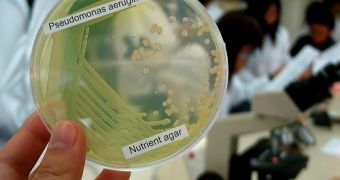Researchers reporting in the Journal of Medical Microbiology, discovered that antibiotic resistance is not just a genetic feature of bacteria, and that in fact they have a second strategy of defense, known as persistence.
This is the first time that researchers proved that there is an interaction between two mechanisms, that help bacteria survive in the fight against antibiotics, and this might as well be the first step towards finding an effective approach to treat multi-drug resistant (MDR) infections.
Pseudomonas aeruginosa is a human pathogen that infects the body given the smallest occasion, being the cause of many hospital-acquired infections.
The worst part is that it can actually cause fatal infections in people suffering from cystic fibrosis.
This bacterium is popular for its capacity to develop a very strong resistance against commonly-used antibiotics and it is nothing unusual for treatments to fail.
The novelty came from scientists at the Center of Microbial and Plant Genetics, at the Katholieke Universiteit Leuven, in Belgium, who discovered that as the bacterial population starts manifesting resistance to the antibiotic fosfomycin, the number of persister cells isolated from Pseudomonas aeruginosa infections decreases.
Persister bacterial cells are hyper-resistant to all antibiotics at once, temporarily – they are able to survive normally lethal levels of antibiotics, without actually being genetically resistant to the drug.
They are one of the main causes of treatment failure, but the problem is that the entire mechanism behind this strength is still unknown.
Professor Jan Michiels, leader of the study, explained that “persister cells are produced in low numbers, but nevertheless make it almost impossible to completely remove the bug from the patient.
“As a result, eradication of infections through antibiotic treatment usually takes a long time.
"Our work shows that antibiotic treatment may also influence the number of persisters formed.”
Professor Michiels admitted that targeting persistence is an attractive option, and that “ideally both susceptible and persistent cells would be targeted in a single therapy, but firstly we need to understand more about the interplay between genetic resistance and persistence to avoid stimulating one or the other.
“Unraveling the mechanism behind bacterial persistence is really important to enable us to optimize treatments of chronic bacterial infections.”
So for now, co-administration therapies (in which drugs targeting non-essential cellular functions are combined with antibiotics) are under development, in order to treat MDR infections.

 14 DAY TRIAL //
14 DAY TRIAL //